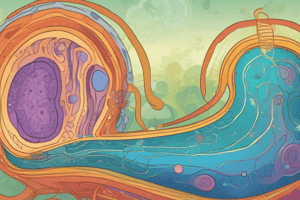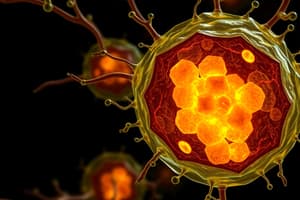Podcast
Questions and Answers
What is the primary function of the mitochondria in cellular metabolism?
What is the primary function of the mitochondria in cellular metabolism?
- To regulate the exchange of molecules between compartments
- To provide mechanical strength to specialized tissues
- To generate and store energy in the form of ATP (correct)
- To synthesize proteins
Which type of cellular respiration occurs in the absence of oxygen?
Which type of cellular respiration occurs in the absence of oxygen?
- Aerobic respiration
- Photosynthesis
- Fermentation
- Anaerobic respiration (correct)
What is the primary function of the cytoskeleton in cellular metabolism?
What is the primary function of the cytoskeleton in cellular metabolism?
- To regulate the exchange of molecules between compartments
- To generate energy in the form of ATP
- To synthesize proteins
- To maintain the cell's shape and internal organization (correct)
Which type of tissue provides general structure, mechanical strength, and physical support for specialized tissues?
Which type of tissue provides general structure, mechanical strength, and physical support for specialized tissues?
What is the primary function of the ribosomes present in mitochondria?
What is the primary function of the ribosomes present in mitochondria?
What is the primary function of the epithelial tissue?
What is the primary function of the epithelial tissue?
What is the primary function of bone tissue in the human body?
What is the primary function of bone tissue in the human body?
What is the primary function of muscle tissue in the human body?
What is the primary function of muscle tissue in the human body?
What is the primary function of the plasma membrane?
What is the primary function of the plasma membrane?
What type of transport requires energy?
What type of transport requires energy?
What is the process called when water travels through a selective permeable membrane to equalize concentrations of solutes?
What is the process called when water travels through a selective permeable membrane to equalize concentrations of solutes?
What type of cell division occurs in sexual organs and leads to the formation of gametes?
What type of cell division occurs in sexual organs and leads to the formation of gametes?
What is the process called when a cell passes through an ordered series of events in which the cell duplicates its contents and divides into two cells?
What is the process called when a cell passes through an ordered series of events in which the cell duplicates its contents and divides into two cells?
What is the main component of the cytoplasm?
What is the main component of the cytoplasm?
What is the function of the sodium-potassium pump?
What is the function of the sodium-potassium pump?
What is the process called when cells divide to replace lost cells?
What is the process called when cells divide to replace lost cells?
What is the approximate duration of mitosis in a 24-hour time span?
What is the approximate duration of mitosis in a 24-hour time span?
How many pairs of chromosomes are present in human cells?
How many pairs of chromosomes are present in human cells?
What is the primary function of the Golgi apparatus?
What is the primary function of the Golgi apparatus?
What is the main difference between free ribosomes and attached ribosomes?
What is the main difference between free ribosomes and attached ribosomes?
What is the role of lysosomes in cellular processes?
What is the role of lysosomes in cellular processes?
What is the primary function of peroxisomes?
What is the primary function of peroxisomes?
What is the correct order of stages in mitosis?
What is the correct order of stages in mitosis?
What is the purpose of meiosis in reproduction?
What is the purpose of meiosis in reproduction?
Flashcards are hidden until you start studying
Study Notes
Cellular Structure and Function
- Mitochondria: powerhouses of the cell, surrounded by double lipid bilayer membrane, participate in oxidative phosphorylation and ATP production, contain own RNA, DNA, and ribosomes
- ATP: stores and transfers energy
Cellular Metabolism
- Anabolism: energy-using process that constructs molecules
- Catabolism: energy-releasing process that deconstructs molecules
- Cellular respiration: two types - aerobic (with oxygen) and anaerobic (without oxygen, unsustainable for a long period)
Tissues
- Basic tissue types: connective, epithelial, muscle, and nervous tissue
- Epithelial tissue: diverse group that includes surface epithelia and solid organs, functions include forming a protective barrier, regulating molecule exchange, and synthesizing and secreting glandular products
- Connective tissue: provides structure, mechanical strength, space-filling, and physical and metabolic support for specialized tissues, with three structural properties: tensile strength, elasticity, and volume
- Specialized connective tissues: bone and cartilage, providing a rigid protective and supporting framework and smooth articular surfaces at bone ends
Cell Membrane and Transport
- Plasma membrane: composed of phospholipids, acts as a barrier, controls substance flow, and participates in intercellular signaling
- Passive transport: does not require energy, includes simple diffusion, facilitated diffusion, osmosis, and filtration
- Active transport: requires energy, includes active transport carriers (pumps) and transport by vesicle formation
- Cytoplasm: ground substance/matrix containing various cellular components, 75-90% water plus solid compounds, and site of chemical reactions
Cell Nucleus and Division
- Nucleus: contains DNA, often referred to as the "brain of the cell"
- Cell division: occurs through mitosis (somatic cells) and meiosis (sex cells)
- Mitosis: consists of four stages - prophase, metaphase, anaphase, and telophase, followed by interphase (G1, S, and G2 sub-phases)
- Meiosis: occurs in sexual organs, testes, and ovaries, leading to gamete formation, and consists of eight stages (two cycles of cell division)
Cell Organelles
- Endoplasmic reticulum: membranous network around the nucleus, site of protein synthesis, with smooth and rough ER
- Ribosome: site of protein synthesis, made of RNA and protein, with free and attached ribosomes
- Golgi apparatus: network of flattened, smooth membranes, packages proteins from the ER into secretory vesicles
- Lysosomes: storage vesicles containing enzymes, break down old organelles and digest foreign substances, play a role in apoptosis
- Peroxisomes: similar to lysosomes, but smaller, involved in detoxification and neutralizing free radicals
Studying That Suits You
Use AI to generate personalized quizzes and flashcards to suit your learning preferences.




